Targeting CoV-2 spike RBD and ACE-2 interaction with flavonoids of Anatolian propolis by in silico and in vitro studies in terms of possible COVID-19 therapeutics
- PMID: 34803452
- PMCID: PMC8576337
- DOI: 10.3906/biy-2104-5
Targeting CoV-2 spike RBD and ACE-2 interaction with flavonoids of Anatolian propolis by in silico and in vitro studies in terms of possible COVID-19 therapeutics
Abstract
Propolis is a multi-functional bee product rich in polyphenols. In this study, the inhibitory effect of Anatolian propolis against SARS-coronavirus-2 (SARS-CoV-2) was investigated in vitro and in silico. Raw and commercial propolis samples were used, and both samples were found to be rich in caffeic acid, p-coumaric acid, ferulic acid, t-cinnamic acid, hesperetin, chrysin, pinocembrin, and caffeic acid phenethyl ester (CAPE) at HPLC-UV analysis. Ethanolic propolis extracts (EPE) were used in the ELISA screening test against the spike S1 protein (SARS-CoV-2): ACE-2 interaction for in vitro study. The binding energy values of these polyphenols to the SARS-CoV-2 spike and ACE-2 protein were calculated separately with a molecular docking study using the AutoDock 4.2.6 program. In addition, the pharmacokinetics and drug-likeness properties of these eight polyphenols were calculated according to the SwissADME tool. The binding energy value of pinocembrin was highest in both receptors, followed by chrysin, CAPE, and hesperetin. Based on the in silico modeling and ADME (absorption, distribution, metabolism, and excretion) behaviors of the eight polyphenols, the compounds exhibited the potential ability to act effectively as novel drugs. The findings of both studies showed that propolis has a high inhibitory potential against the Covid-19 virus. However, further studies are now needed.
Keywords: Covid-19; Propolis; SARS-CoV-2; molecular docking; pinocembrin.
Copyright © 2021 The Author(s).
Conflict of interest statement
CONFLICT OF INTEREST: No conflict of interest is declared.
Figures
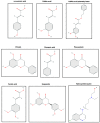
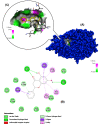
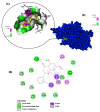
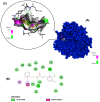

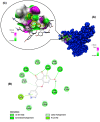
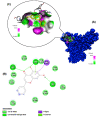

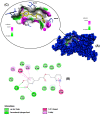


Similar articles
-
Investigation of potential inhibitor properties of ethanolic propolis extracts against ACE-II receptors for COVID-19 treatment by molecular docking study.Arch Microbiol. 2021 Aug;203(6):3557-3564. doi: 10.1007/s00203-021-02351-1. Epub 2021 May 5. Arch Microbiol. 2021. PMID: 33950349 Free PMC article.
-
Propolis, Bee Honey, and Their Components Protect against Coronavirus Disease 2019 (COVID-19): A Review of In Silico, In Vitro, and Clinical Studies.Molecules. 2021 Feb 25;26(5):1232. doi: 10.3390/molecules26051232. Molecules. 2021. PMID: 33669054 Free PMC article. Review.
-
Uncaria tomentosa (cat's claw): a promising herbal medicine against SARS-CoV-2/ACE-2 junction and SARS-CoV-2 spike protein based on molecular modeling.J Biomol Struct Dyn. 2022 Mar;40(5):2227-2243. doi: 10.1080/07391102.2020.1837676. Epub 2020 Oct 29. J Biomol Struct Dyn. 2022. PMID: 33118480 Free PMC article.
-
Anti-Viral and Immunomodulatory Properties of Propolis: Chemical Diversity, Pharmacological Properties, Preclinical and Clinical Applications, and In Silico Potential against SARS-CoV-2.Foods. 2021 Jul 31;10(8):1776. doi: 10.3390/foods10081776. Foods. 2021. PMID: 34441553 Free PMC article. Review.
-
Phenolic Profile, Antioxidant Capacities and Enzymatic Inhibitory Activities of Propolis from Different Geographical Areas: Needs for Analytical Harmonization.Antioxidants (Basel). 2020 Jan 15;9(1):75. doi: 10.3390/antiox9010075. Antioxidants (Basel). 2020. PMID: 31952253 Free PMC article.
Cited by
-
Consumption of Phenolic-Rich Food and Dietary Supplements as a Key Tool in SARS-CoV-19 Infection.Foods. 2021 Sep 3;10(9):2084. doi: 10.3390/foods10092084. Foods. 2021. PMID: 34574194 Free PMC article. Review.
-
Expression of Human β-defensin 2 (hBD-2) in Pichia Pastoris and Investigation of Its Binding Efficiency with ACE-2.Protein J. 2023 Aug;42(4):399-407. doi: 10.1007/s10930-023-10130-8. Epub 2023 Jun 9. Protein J. 2023. PMID: 37291459 Free PMC article.
-
Structure-based Virtual Screening from Natural Products as Inhibitors of SARS-CoV-2 Spike Protein and ACE2 Receptor Binding and their Biological Evaluation In vitro.Med Chem. 2024;20(5):546-553. doi: 10.2174/0115734064279323231206091314. Med Chem. 2024. PMID: 38204279
-
Development of a screening platform to discover natural products active against SARS-CoV-2 infection using lung organoid models.Biomater Res. 2023 Mar 1;27(1):18. doi: 10.1186/s40824-023-00357-y. Biomater Res. 2023. PMID: 36855173 Free PMC article.
-
Therapeutic Potential of Glycosyl Flavonoids as Anti-Coronaviral Agents.Pharmaceuticals (Basel). 2021 Jun 7;14(6):546. doi: 10.3390/ph14060546. Pharmaceuticals (Basel). 2021. PMID: 34200456 Free PMC article. Review.
References
-
- Aliyazıcıoglu R Sahin H Erturk O Ulusoy E Kolaylı S Properties of phenolic composition and biological activity of propolis from Turkey. International Journal of Food Properties. 2013;16:277–287.
-
- Andrade JKS Denadai M de Oliveira CS Nunes ML Narain N Evaluation of bioactive compounds potential and antioxidant activity of brown, green and red propolis from Brazilian northeast region. Food Research International. 2017;101:129–138. - PubMed
-
- Bankova V Bertelli D Borba R Conti BJ Standard methods for Apis mellifera propolis research. Journal of Apicultural Research. 2019;58:1–49.
-
- Bankova V Galabov AS Antonova D Vilhelmova N Di Perri B Chemical composition of propolis extract ACF® and activity against herpes simplex virus. Phytomedicine. 2014;21:1432–1438. - PubMed
LinkOut - more resources
Full Text Sources
Other Literature Sources
Miscellaneous
